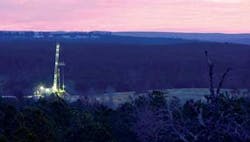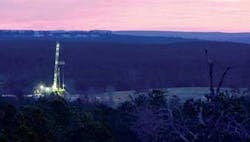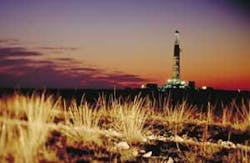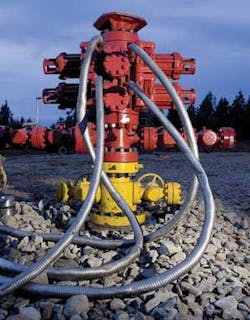Harold Korell directs turnaround at Southwestern
Southwestern Energy Co. is one of the feel-good, comeback stories of the past few years in the E&P sector - the kind of overcoming-the-odds narrative that makes careers for the entire management team.
The Houston-based company has bounced back from the brink of disaster in 1998, when the company ended up on the losing end of a $109 million lawsuit. Southwestern’s total market capitalization at that time was just $187million, and the company was in a tailspin.
Fast forward to April 29, 2005. Southwestern announced its financial and operating results for the first quarter. Highlights include:
- Record earnings of $32.6 million - up 33 percent from the first quarter of 2004.
- Record cash provided by operating activities of $73.6 million - up 30 percent from the same period in 2004.
- Natural gas and crude oil production of 14.0 bcfe - up 22 percent over first quarter 2004 levels.
- Proved reserves increased by 28 percent, replacing 365 percent of 2004 production.
- Market capitalization more than $2 billion.
As news of Southwestern’s turnaround became widely known, stock prices soared to nearly $70 a share. On May 4, the company’s stock closed at $67.30 on the New York Stock Exchange - down slightly from a 52-week high of $68.48 and up from a low of $22.65 on March 24, 2004 - just a little more than a year earlier.
Much of the company’s good fortune can be attributed to the skills and common sense applied by one individual - Harold M. Korell, who joined then Arkansas-based company in April 1997 as executive vice president and COO and soon realized he had boarded a “sinking ship.”
“The E&P part of the business had been poorly run and generally it was in disarray,” said Korell. After a few months, I asked myself, ‘What had I gotten myself into?’”
A native of Wyoming, Korell is a graduate of the Colorado School of Mines with a degree in chemical and petroleum refining engineering. He began his career with Mobil Oil Corp. and subsequently held various positions with Houston-based Tenneco Oil Co. from 1973 to 1989, including vice president of production.
From 1990 to 1992, he served as executive vice president of McCormick Resources, and from 1992 to 1997, he was employed by American Exploration Co. as senior vice president of operations.
Instead of leaving Southwestern, Korell chose to stay and try to rebuild the company. His first setback was losing the $109 million lawsuit in Arkansas state courts, which prompted him to move the company headquarters to Houston.
“I loved Fayetteville (then headquarters for Southwestern) and still have a lake house near there, but I felt we could not win in that environment,” said Korell. “I urged the board to move the headquarters to Houston, the center of the energy industry, and they agreed.”
Building a team
Korell had been appointed president of Southwestern in October 1998 and CEO the following January. In May 2002, he added chairman of the board to his list of titles.
He began rebuilding the management team in early 1998. Among Korell’s senior staff is Richard F. Lane, executive vice president of exploration and production. He had worked closely with Korell at American Exploration Co., where he was offshore exploration manager. Lane holds bachelor’s and master’s degrees in geology from the University of Houston and is a graduate of the executive finance program at the Anderson School of Business at the University of California at Los Angeles.
Korell kept Greg D. Kerley, who had joined Southwestern in 1990 as controller and chief accounting officer. Previously, he held senior financial accounting positions at Agate Petroleum Inc and was a manager for Arthur Andersen LLP, specializing in the energy sector. Kerley now serves as executive vice president and CFO.
Another senior executive, Mark K. Boling, came to the company in January 2002 as senior vice president, general counsel, and secretary. By December of that year, he was promoted to executive vice president. Boling holds a JD degree from Southern Methodist University Law School and a BS in geology from DePauw University in Greencastle, Ind. He was a partner with Fulbright & Jaworski LLP in Houston, where he was employed from 1982 to 1993, and had a private law practice specializing in the oil and gas industry from 1993 until he joined Southwestern.
Alan N. Stewart serves as executive vice president of Arkansas Western Gas Co., Southwestern’s Fayetteville-based natural gas distribution subsidiary, which serves approximately 145,000 customers in northern Arkansas. He was appointed to the position in March 2004. Prior to joining the company, Stewart was a consultant to clients in the energy and LNG industries in California, and before that he served in a variety of managerial positions for San Diego Gas & Electric Co. and Southern California Gas Co.
Nearly 90 percent of Arkansas Western’s revenues are from residential and commercial markets, and the company provides predictable earnings and cash flow streams for Southwestern. In other words, it is a “cash cow.”
In addition to Southwestern’s utility operations, the company holds a 25 percent general partnership interest in the NOARK Partnership, which owns the Ozark Pipeline, a 723-mile interstate pipeline.
Rebuilding a company
How did Southwestern achieve this dramatic turnaround? Mostly the old-fashioned way - by focusing on the company’s core competencies, increasing production, adding low-cost reserves, improving efficiencies, lowering drilling costs, reducing debt, and investing wisely.
The company is primarily focused on the exploration for and production of natural gas. Year-end 2004 reserves totaled 645 bcfe, 92 percent of which were natural gas and 83 percent of the reserves were “proved developed.” Reserve life is approximately 11.9 years, and 2004 production was 54.1 bcfe.
Southwestern’s E&P activities are confined to a five-state area (Texas, Louisiana, Arkansas, Oklahoma, and New Mexico) in the Arkoma basin, Permian basin, East Texas, and onshore along the Texas-Louisiana Gulf Coast.
Southwestern’s operations in East Texas are primarily in the Overton field, which provides the company with a low-risk, multi-year drilling program with significant production and reserve growth potential. Production in the Overton field has increased from 2.0 MMcfe/d in March 2001 to about 90 MMcfe/d on Dec. 31, 2004. The field has nearly 300 bcfe, representing about 47 percent of the company’s proved reserves and 41 percent of total production.
In 2005, Southwestern expects to invest about $147.6 million in East Texas, which includes drilling 96 wells, 80 in the Overton field. The strategy here is to add production and reserve growth with low-risk drilling.
In the Permian Basin, Southwestern is pursuing a strategy of medium-risk exploration and exploitation drilling. At this time, reserves here are about 61 bcfe - about nine percent of the company’s total proved reserves. Production in 2004 was 7.1 bcf, or about 13 percent of total production.
For 2005, Southwestern expects to invest approximately $4.8 million in the Permian Basin to drill 12 exploration and exploitation wells.
In 2005, Southwestern expects to invest about $4.8 million in the onshore Gulf Coast region to drill up to eight wells, with most being developmental in nature. The company’s strategy is to reduce its high-risk exploration activity in this area.
In the Arkoma basin (Oklahoma and Arkansas), conventional operations provide low-risk drilling opportunities and a stable production and reserve base. In 2005, Southwestern expects to invest approximately $60 million, which includes drilling about 86 wells - about 43 in the company’s Ranger anticline area. The strategy for this area is to continue low-risk development drilling and workover programs that help maintain production and reserves.
Fayetteville shale
The Fayetteville shale play on the Arkansas side of the Arkoma basin is an unconventional gas reservoir, ranging in depths from 1,500 to 6,500 feet. The Fayetteville shale is a Mississippian-age shale that is the geologic equivalent of the Caney shale found on the Oklahoma side of the Arkoma basin and the Barnett shale found in North Texas.
Up until Southwestern began its work in 2002, the Fayetteville shale potential had gone unnoticed. However, in early 2002, Southwestern was trying to map the Wedington sands in the conventional part of the Arkoma basin. For some reason, wells in this area were producing four to five times as much gas as expected, and for this reason, the area came to be called the “Wedington Incongruity.”
“Our conclusion was that the [Fayetteville] shale must be contributing to the production - it must be the source rock,” said Korell. “We discovered that the shale appeared to be laterally extensive and ranged in thickness from 50 to 325 feet and depths from 1,500 to 6,500 feet. We were excited about this and decided to start leasing.”
The company began acquiring acreage soon after realizing the economic potential of the play. Lately, Southwestern has been on a spree, obtaining rights to well over half a million acres in the area. The company’s actions did not go unnoticed, however. In the past year, more than a few competing independent producers have begun acquiring acreage as well, creating a bonanza of sorts for local land owners.
To date, Southwestern has acquired approximately 630,000 net acres in the undeveloped play area and controlled another 125,000 net acres in the Fairway area of the basin that is held by conventional production. Total proved gas reserves booked in the play in 2004 totaled 7.5 bcf from a total of 20 wells, 10 of which were classified as proved, undeveloped locations.
Up to $100 million, about 29 percent of the E&P capital budget, has been allocated to activities in the Fayetteville shale in 2005. This is second only to the $148 million allocated to the East Texas operations and is an indication of how strongly company management feels about the potential there.
During the first quarter of 2005, Southwestern invested about $20 million in the play, which included $12 million of capital for drilling 18 wells, $7 million for leasehold acquisitions, and $1.3 million for other capitalized costs. By the end of the quarter, the company had drilled 38 wells in six pilot areas in four separate counties in the play and participated in one outside-operated well.
Management strategy is to continue to pursue the Fayetteville shale potential, and the company has begun testing horizontal wells with encouraging results, said Korell.
New credit facility
In January, Southwestern closed on a new $500 million, five-year unsecured revolving credit facility, which has terms consistent with investment-grade companies. Funds will be available for general corporate purposes, including the repayment of outstanding indebtedness.
JPMorgan Securities Inc and SunTrust Robinson Humphrey, a division of SunTrust Capital Markets Inc., were co-lead arrangers and joint book runners. JPMorgan Chase Bank NA is the administrative agent and a lender under the facility. SunTrust Bank acted as syndication agent and Royal Bank of Canada, Royal Bank of Scotland, and Fleet National Bank served as co-documentation agents. In addition to the agents, 11 other banks are also lenders under the facility.
The credit facility provides the company with increased liquidity and the financial flexibility over the next few years to execute its strategy of providing long-term growth in the net asset value of the business.
And, on Feb. 28, Southwestern announced that its board of directors had approved a two-for-one stock split, reflecting the excellent operational results in the company’s E&P business over the past few years, said a company news release.
Analyst briefing
In a May 2 teleconference call with nine industry analysts, Harold Korell, Richard Lane, and Greg Kerley discussed the company’s first quarter financial results, which were the best in the company’s history. Southwestern set new records for earnings and cash flow, which Korell attributed to “production growth and higher commodity prices.”
He mentioned that the company continued to have excellent results in the drilling programs in the Overton field in East Texas and the Ranger anticline in the Arkoma basin. Then he and Lane mentioned that the company continued to make progress in the Fayetteville shale play.
When it came time for the analysts to question Southwestern’s management team, they all wanted to know more about the shale. Was it developing as fast as the company wanted? Were there equipment or other constraints? Were there any surprises? What sort of variability were they seeing?
The response was that it is still fairly early in the development of the play and that a lot more development needs to be done before enough is known to reach significant conclusions.
With regard to finding costs and proved reserves, Lane commented, “We’re not to the point there where we know what those are or what they will be at the end of the year.”
The company is currently averaging three rigs in the shale, with another moving in and out, said Lane. Depending on the mix of horizontals and verticals, the rig count could increase to five to 10 by the end of the year, he added.
Asked how horizontal drilling adds value in the Fayetteville shale, Korell responded: “We think that, logic would tell us, that we’ll get in contact with more of the rock if we drill a horizontal well and do multiple-stage fracing along that than we would if we drill vertically through that same section. . .The name of the game here is going to be to get in contact with the most rock you can per dollar invested.”
As the session concluded, Korell noted that the company is off to a great start in 2005 with its E&P program and is confident that progress is being made in understanding and pushing forward with the Fayetteville shale play.
“We think we’re looking at a very bright year for the company overall,” he added. OGFJ





